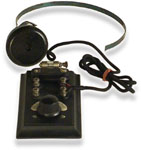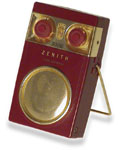Antique radios, Old Time Radios


For the Museum Finder click here.
Important Note!
The pages (framed in brown) are for people with a more general interest in antique radios. These pages are still under construction, but feel free to click on any picture and/or link now. It is suggested, however, to start with the blue information icons. Pages framed in green, which include the «Forum», «Papers», etc. are of special interest to collectors and others with a deeper interest in the whole field of radio technology. |
|
 |
First Ever Radios
The first, really workable device using electricity was the telegraph by Morse in 1835 - one initial step to telecommunication. Beginning in 1855, Caselli even transmitted pictures using his pantelegraph. While efforts were underway from about 1832 to develop electric motors, it took a few more decades until they had evolved into devices for practical use. Almost at the same time (1876), the telephone and the practicable light bulb (Swan 1878, Edison 1879) came into being.
Commencing in 1890, first possibilities were explored to deliberately create and receive radio waves. In that, from 1896 onwards, the leading head was Marconi, whose work lead to wireless telecommunication. There were also a number of other inventors who, however, barked up the wrong tree; e.g. von Lieben (with his electronic relais, 1906-1910). |
|
|
|
Decades of Broadcast Receivers
It was Edison who realized in 1877 the goal of speech recording using the phonograph. The gramophone by Berliner followed in 1885. After that, there appeared for some time rather expensive music boxes employing drums, plates, etc. Prior to that time, one had to make one’s own music or attend a live performance. Only through the thermionic valve or tube (Fleming 1904, de Forest 1907) could the wireless transmission of speech and music be seriously contemplated. Broadcasting as we know it now came into being in the early ‘20s and one soon talked about radio fever. Radios were a piece of technology; it was not uncommon to make it a do-it-yourself project. It didn’t take long for radios to become an integrated part of one’s home. Of importance were an attractive housing to please the lady of the house, simplified controls so that everyone could operate it. Each of the following decades came up with its own technical as well as stylistic modifications and characteristics.
|
 |
 |
Crystal Receivers
Even today, it’s still possible to operate a radio without exterior power; i.e. solely on energy gathered by the antenna. Not surprisingly, reception is limited and listening restricted to earphones. It’s worth to note, however, that radio signal reception did not have its inception with a crystal detector. Both, radio valves/tubes and detectors were invented around 1907. However, radios were significantly more expensive in the original purchase as well as in the daily operation for which reason crystal receivers enjoyed great popularity in the early ‘20s. For the same reason, namely cost, many a radio was assembled in do-it-yourself fashion.
|
Multifunctional Radios
Pocket-, and later wristwatches were still rather expensive; the clock high up on the church tower not always in sight or hearing distance. But one had a clock at home - and soon the clock, sometimes even alarm clock became an integral part of the radio. As an aside, the technical development of time keeping is quite an interesting subject on its own. Another popular combination was, almost unavoidably, the integration of the record player and later the tape recorder. Later on came integrated cassette recorders and CD players. Pictured on the right is an Executive Radio of the ‘30s: There is the ink-well and two pens, one each for the contract signing parties. Integrated clock and the radio (to listen to news on the economy?). Other combinations that followed were with a camera or more recently with a mobile phone.
|
 |
 |
Promotional and Children’s Radios
Especially in the U.S. it was soon discovered that radio technology not only lends itself to transmit commercials: Radios, more accurately receivers, also make excellent promotional objects. This development started already in the very early twenties but went totally different ways in the U.S. and in Europe: Privately owned radio stations in the U.S. are financed through selling advertising spots while government supported broadcasters in Europe are not allowed to run commercials.
Recognizing an additional market, the industry made radios accessible to children as well. Though built explicitly for use by children, these radios were not always the most suitable in design and manufacturing details for the stated purpose. There are also radios made specifically to be given away for promotional reasons.
More... |
|
High Tech - and Design-Radios
In its beginnings, the radio was a purely technical affair - quite often not that easy to operate. With regard to its often stormy evolution commencing in the ‘20s, a parallel can be drawn to the development of PCs in the ‘70s. In addition, radios had to conform in appearance with prevailing lifestyle. At a time when few people could afford an automobile, the radio became a status symbol; together with other (then) gadgets such as a refrigerator. Affluent people would demonstrate their wealth by owning extravagant radios or those with special technical characteristics - or both.
|
 |
 |
«Travelling Radios» (Portables)
Right from the beginning of the radio era, the wish existed to take the radio along to picnics and other social events. This demand was originally met with wooden boxes of some substance. They contained accumulators, batteries, loop arial and, of course, the actual receiver plus speaker. Already in the mid-twenties, radios were installed in automobiles. At that early stage, they took up a lot of space. This only changed in the ‘50s when, thanks to transistorization, reasonable dimensions and standardized installation sizes had been achieved. |
Transistor Radios
Although the efforts of John Bardeen, Walter Brattain and William Shockley opened the way to workable, technical applications of the transistor already by the end of 1947, it took until 1954 for the transistor radio to be ready for series production. Initially, transistors were several times the cost of tubes/valves; moreover, there were clear limitations with regards to high frequency suitability. The two areas in which transistorized radios succeeded at about the same time were portables and car radios. The reasons for that can be found in the much smaller dimensions becoming now possible; but most of all it was the drastically reduced power requirements: No longer was it necessary to provide for cathode heating. It took another 10 years before the transistor began to displace electronic tubes/valves in home radios. |
 |
 |
All about Radio and TV
TV sets are radio receivers too. The development of TV sets for practical use commenced in the mid-twenties, but it wasn’t until after WW II, at least in Europe, that TVs reached a market share worth mentioning. It was the advent of colour TV in the ‘60s that changed this and made the latest entry into the home entertainment market the new status symbol, pushing the radio aside.
But let’s go back to the dawn of the radio era. At that early stage many additional devices were needed to enjoy the experience of radio reception. In chapter «Collecting» you will find more on the subject and learn among other things about developments on the broadcasting side. (e.g. microphones). GPS could become another topic. |
Special Application Receivers
Amateur radio operators have a special frequency range allocated to them and other requirements had to be met. Specialized equipment was developed right from the beginning for military applications, embassies, etc. Transceivers, capable of sending and receiving, are one outcome of these efforts. Only much later came other types of receivers which we today still consider as rather «out of the ordinary», though it’s foreseeable that this new generation of radio equipment will be the mainstay in a very few years (e.g. satellite receivers).
Translation: Alfred Zeeb, Canada
|
23.mar.2005 21.nov.2011 10.apr.2025










